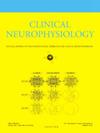慢性脑卒中中异常mu节律状态相关的皮层和皮质脊髓反应。
IF 3.6
3区 医学
Q1 CLINICAL NEUROLOGY
引用次数: 0
摘要
目的:运动皮层的活动具有状态依赖性。具体来说,感觉运动mu节律期与初级运动皮层(M1)兴奋性的变异性有关,这在年轻和健康的志愿者中已经得到证实。目前尚不清楚这一观察结果是否适用于中风相关脑损伤患者。方法:结合脑电图实时处理和经颅磁刺激(TMS)对M1进行脑电刺激,研究mu振荡与皮层兴奋性的相位关系。在N = 23名志愿者(慢性中风幸存者和健康对照)中,我们在mu振荡的四个阶段对M1应用TMS。我们研究了运动诱发电位(MEP)和颅磁诱发电位(TEP)的振幅。结果:脑卒中幸存者和老年志愿者的MEP振幅表现出相依赖性,在mu节律波谷时MEP增加,在峰值时MEP减少。然而,与中风相关的运动症状较强的个体表现出较低的相偏好。与未受影响的脑半球相比,受中风影响的脑半球tep的相位依赖性降低。在健康志愿者中,没有发现半球差异。结论:经颅磁刺激运动反应的相位偏好强度可以反映运动损伤的严重程度。意义:本研究结果为脑卒中后运动功能障碍恢复的经颅磁刺激模式的发展提供了基础。本文章由计算机程序翻译,如有差异,请以英文原文为准。
Abnormal mu rhythm state-related cortical and corticospinal responses in chronic stroke
Objective
The motor cortex’s activity is state-dependent. Specifically, the sensorimotor mu rhythm phase relates to the variability of primary motor cortex (M1) excitability, previously demonstrated in young and healthy volunteers. It is unknown whether this observation is generalizable to individuals with stroke-related brain lesions.
Methods
We investigated the phase relationship between mu oscillations and cortical excitability by combining real-time processing of electroencephalography (EEG) and transcranial magnetic stimulation (TMS) of M1. In N = 23 volunteers (chronic stroke survivors and healthy controls), we applied TMS to M1 at four phases of the mu oscillation. We investigated motor-evoked (MEP) and TMS-evoked potential (TEP) amplitudes.
Results
MEP amplitude in stroke survivors and older volunteers showed a phase-dependency with increased MEPs at the trough and decreased MEPs at the peak of the mu rhythm. However, individuals with stronger stroke-related motor symptoms showed a decreased phase preference. Phase-dependency of TEPs was reduced in the stroke-affected hemisphere, compared to the non-affected hemisphere. In healthy volunteers, no hemispheric difference was found.
Conclusion
Our preliminary results indicate that the strength of phase preference of TMS motor responses could indicate the severity of motor impairment.
Significance
These results could enable the development of improved TMS paradigms for recovery of motor impairment after stroke.
求助全文
通过发布文献求助,成功后即可免费获取论文全文。
去求助
来源期刊

Clinical Neurophysiology
医学-临床神经学
CiteScore
8.70
自引率
6.40%
发文量
932
审稿时长
59 days
期刊介绍:
As of January 1999, The journal Electroencephalography and Clinical Neurophysiology, and its two sections Electromyography and Motor Control and Evoked Potentials have amalgamated to become this journal - Clinical Neurophysiology.
Clinical Neurophysiology is the official journal of the International Federation of Clinical Neurophysiology, the Brazilian Society of Clinical Neurophysiology, the Czech Society of Clinical Neurophysiology, the Italian Clinical Neurophysiology Society and the International Society of Intraoperative Neurophysiology.The journal is dedicated to fostering research and disseminating information on all aspects of both normal and abnormal functioning of the nervous system. The key aim of the publication is to disseminate scholarly reports on the pathophysiology underlying diseases of the central and peripheral nervous system of human patients. Clinical trials that use neurophysiological measures to document change are encouraged, as are manuscripts reporting data on integrated neuroimaging of central nervous function including, but not limited to, functional MRI, MEG, EEG, PET and other neuroimaging modalities.
 求助内容:
求助内容: 应助结果提醒方式:
应助结果提醒方式:


